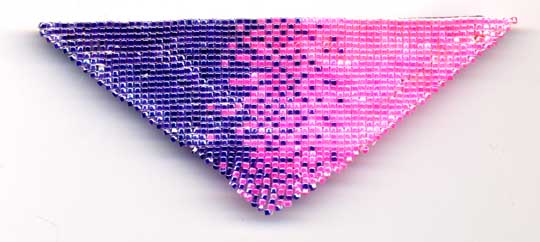|
Color Gradations in Seed Bead Art
Painters can just mix a couple of colors together to get a middle color. In seed bead art, we often do not have that choice available. Now those coatings and treatments will produce different effects and diffuse the light in various ways, giving the effect of different hues, but if you wanted to give the effect of, say, a blue vase in the background of a still life, you probably would not want to use the brightness of silver-lined blue beads, or blue beads with an aurora borealis (AB) finish because it would just be too bright. You could use opaque blue beads, and you can probably find 3 to five shades of plain blue beads. Being able to blend from one color to the next, to give the appearance of graduated color, gives more room to play in the somewhat limited palette of bead colors available. One easy place to see the range available in seed beads in at the Toho Beads website where they have a 2-page Sample Card for Aiko Beads that is arranged by color gradation. It's a pretty cool resource, and one that I have been going back to from time to time. Maybe I should buy the actual sample cards instead of just staring at my computer monitor. . . . The Challenge
Using the technique of your choice, weave a square with 2 colors blending into each other. The most straightforward way to do this is to start at one end with the first color, bead about 20% of your square, then begin adding a few single beads of the second color, increasing their frequency until it is a pretty even mix of the 2 colors at the middle of the piece. Then you can begin to bring use your first color in smaller and smaller amounts until you reach the final 20% of your square, which will be completely in your second color. The goal of this exercise is to get a nice even blend from one color to the next. Variations1. Make a longer and slower transition from one color to the next. This might become a nice bracelet. 2. Use more than 2 colors. 3. Instead of blending across in a straight line, make a roundish shape of one color and blend outward from it. You can see something of the sort on the small, light blue example above. CommentsYou are welcome to chart out your use of color for this if you want to, but I encourage you to just do it as you go along, paying attention to the beads and the effect you are getting. To me, seed bead art is easier and more fun when I pay attention to what is happening with the work and adjust as needed. What Will I Do with All These Artsy Samples?You can take a peek at Practical Uses for Color Samples to get some ideas for turning your experimental learning bits into interesting examples of seed bead art. Show Us Your Color Gradation Piece!You can show us your results, so we can all learn from each other. Whether it's a piece you just did because of what you read here, or if it is something you did in the past that fits into this discussion, please consider sharing it. See What Other Beaders Have DoneClick below to see contributions from other visitors to this page...
Laura Fisher's Spiral Rope Not rated yet
Seed Bead Spiral Rope in Gradient Blues Not rated yet Subscribe to "What's New at SeedBeadSmarts" by Email
|

